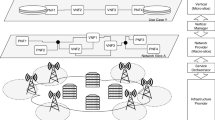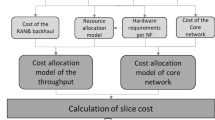Abstract
Recently, the increasing demand for low latency, the explosive growth in the volume of network traffic, the large and growing number of connected devices, and diversified multimedia applications have paved the way for a new era of mobile networks. To meet these diverse requirements of different businesses in network virtualization, network slicing has emerged as a promising paradigm of upcoming 5G mobile networks. Network slicing is a major technology, based on network function virtualization and software defined network technologies, which aims to achieve more efficient utilization of available network traffic and reduce operating costs. In this paper, we propose a network slicing architecture for 5G mobile networks involving cloud radio access network (C-RAN), mobile edge computing (MEC), and cloud data center. We model the proposed network slicing system based on queueing theory, which can be used to derive the main performance metrics such as the CPU utilization, system throughput, system drop rate, average number of message requests, average response time, and average waiting time. We provide quantitative examples to show how this proposed model could be applied to estimate the system performance and cost for a network slicing system in 5G mobile networks and the number of C-RAN and MEC cores required under diverse 5G traffic conditions. The analytical results and simulation models indicate that the proposed model has a powerful ability to assign the number of C-RAN and MEC cores required to achieve the quality of service targets of 5G slices.












Similar content being viewed by others
References
Choi, Y.-I., & Park, N. (2017). Slice architecture for 5G core network. In 9th International conference on ubiquitous and future networks (ICUFN), 2017 (pp. 1–7).
Pérez-Romero, J. et al. (2018). On the configuration of radio resource management in a sliced RAN. In IEEE/IFIP network operations and management symposium, 2018 (pp. 1–9).
Agiwal, M., Roy, A., & Saxena, N. (2016). Next generation 5G wireless networks: A comprehensive survey. IEEE Communications Surveys & Tutorials,18(3), 1617–1655.
Yousaf, F. Z., et al. (2017). NFV and SDN-key technology enablers for 5G networks. IEEE Journal on Selected Areas in Communications,35(11), 2468–2478.
Velasco, L., et al. (2018). An architecture to support autonomic slice networking. Journal of Lightwave Technology,36(1), 135–141.
Wei, H., Zhang, Z., & Fan, B. (2017). Network slice access selection scheme in 5G. In IEEE 2nd information technology, networking, electronic and automation control conference (ITNEC), 2017 (pp. 1–8).
Richart, M., et al. (2016). Resource slicing in virtual wireless networks: A survey. IEEE Transactions on Network and Service Management,13(3), 462–476.
Nguyen, V.-G., et al. (2017). SDN/NFV-based mobile packet core network architectures: A survey. IEEE Communications Surveys and Tutorials,19(3), 1567–1602.
Kalyoncu, F., Zeydan, E., & Yigit, I. O. (2018) A data analysis methodology for obtaining network slices towards 5G cellular networks. In IEEE 87th Vehicular Technology Conference (VTC Spring) (pp. 1–7).
Afolabi, I., et al. (2017). End-to-end network slicing enabled through network function virtualization. In IEEE Conference on Standards for Communications and Networking (CSCN) (pp. 1–8).
Olwal, T. O., Djouani, K., & Kurien, A. M. (2016). A survey of resource management toward 5G radio access networks. IEEE Communications Surveys & Tutorials,18(3), 1656–1686.
Checko, A., et al. (2015). Cloud RAN for mobile networks—A technology overview. IEEE Communications surveys & tutorials,17(1), 405–426.
Taleb, T., et al. (2017). On multi-access edge computing: A survey of the emerging 5G network edge cloud architecture and orchestration. IEEE Communications Surveys & Tutorials,19(3), 1657–1681.
Foukas, X., et al. (2017). Network slicing in 5G: Survey and challenges. IEEE Communications Magazine,55(5), 94–100.
Zhang, L., et al. (2018). Filtered OFDM systems, algorithms, and performance analysis for 5G and beyond. IEEE Transactions on Communications,66(3), 1205–1218.
Akihiro, N., et al. (2017). End-to-end Network Slicing for 5G Mobile Networks. Journal of Information Processing,25, 153–163.
Chen, H., & Yao, D. D. (2013). Fundamentals of queuing networks: Performance, asymptotic, and optimization (Vol. 46). Berlin: Springer.
Bolch, G., et al. (2006). Queuing networks and Markov chains: Modeling and performance evaluation with computer science applications. Hoboken: Wiley.
Bhat, U. N. (2015). An introduction to queuing theory: Modeling and analysis in applications. Basel: Birkhäuser.
Liang, C., & Yu, F. R. (2015). Wireless network virtualization: A survey, some research issues and challenges. IEEE Communications Surveys & Tutorials,17(1), 358–380.
Han, B., et al. (2018). Admission and congestion control for 5G network slicing. In IEEE Conference on Standards for Communications and Networking (CSCN) (pp. 1–9).
Narmanlioglu, O., Zeydan, E., & Arslan, S. S. (2018). Service-aware multi-resource allocation in software-defined next generation cellular networks. IEEE Access,6, 20348–20363.
Ye, Q., et al. (2019). End-to-end delay modeling for embedded VNF chains in 5G core networks. IEEE Internet of Things Journal,6(1), 692–704.
Kurtz, F., et al. (2018). Network slicing for critical communications in shared 5G infrastructures-an empirical evaluation. In 4th IEEE Conference on Network Softwarization and Workshops (NetSoft) (pp. 1–9).
Zanzi, L., & Sciancalepore, V. (2018) On guaranteeing end-to-end network slice latency constraints in 5G networks. In 15th International Symposium on Wireless Communication Systems (ISWCS) (pp. 1–8).
Costanzo, S., et al. (2018). Dynamic network slicing for 5G IoT and eMBB services: A new design with prototype and implementation results. In 3rd Cloudification of the Internet of Things (CIoT) (pp. 1–9).
Matthiesen, B., Aydin, O., & Jorswieck, E. A. (2018). Throughput and energy-efficient network slicing. In 22nd International ITG Workshop on Smart Antennas, 2018 (pp. 1–9).
Afolabi, I., et al. (2018). Network slicing and softwarization: A survey on principles, enabling technologies, and solutions. IEEE Communications Surveys & Tutorials,20(3), 2429–2453.
Toosi, A. N., et al. (2019). Management and orchestration of network slices in 5G, fog, edge and clouds (pp. 79–101). Fog and Edge Computing: Principles and Paradigms.
Sahner, R. A., Trivedi, K., & Puliafito, A. (2012). Performance and reliability analysis of computer systems: An example-based approach using the SHARPE software package. Berlin: Springer.
Nelson, R. (2013). Probability, stochastic processes, and queueing theory: The mathematics of computer performance modeling. Berlin: Springer.
Bertoli, M., Casale, G., & Serazzi, G. (2009). JMT: Performance engineering tools for system modeling. ACM SIGMETRICS Performance Evaluation Review,36(4), 10–15.
Fishman, G. S. (2013). Discrete-event simulation: Modeling, programming, and analysis. Berlin: Springer.
Acknowledgements
This work was supported by the Research Center of College of Computer and Information Sciences, King Saud University. The authors are grateful for this support.
Author information
Authors and Affiliations
Corresponding author
Ethics declarations
Conflict of interest
All authors declare that they have no conflict of interest.
Additional information
Publisher's Note
Springer Nature remains neutral with regard to jurisdictional claims in published maps and institutional affiliations.
Rights and permissions
About this article
Cite this article
AlQahtani, S.A., Alhomiqani, W.A. A multi-stage analysis of network slicing architecture for 5G mobile networks. Telecommun Syst 73, 205–221 (2020). https://doi.org/10.1007/s11235-019-00607-2
Published:
Issue Date:
DOI: https://doi.org/10.1007/s11235-019-00607-2




